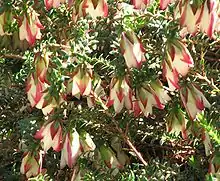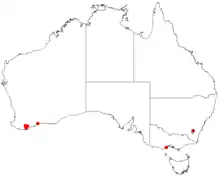Darwinia macrostegia
Darwinia macrostegia, commonly known as Mondurup bell, is a shrub which is endemic to a localised area near Albany in Western Australia. It usually grows to between 0.3 and 0.9 metres in height and produces red and white flowers between late autumn and late spring.[2]
| Mondurup bell | |
|---|---|
 | |
| Scientific classification | |
| Kingdom: | Plantae |
| Clade: | Tracheophytes |
| Clade: | Angiosperms |
| Clade: | Eudicots |
| Clade: | Rosids |
| Order: | Myrtales |
| Family: | Myrtaceae |
| Genus: | Darwinia |
| Species: | D. macrostegia |
| Binomial name | |
| Darwinia macrostegia | |
 | |
| Occurrence data from AVH | |
| Synonyms[1] | |
The species was first formally described in 1849 by Nikolai Turczaninow who gave it the name Genetyllis macrostegia and published the description in Bulletin de la Société Impériale des Naturalistes de Moscou.[3][4] In 1865, George Bentham changed the name to Darwinia macrostegia.[5]
The Mondurup bell occurs in the Stirling Range National Park in five separate populations.[6]
A 1951 newspaper article about "Mondurup" in the Stirling Range described this plant as "The Climber's Badge".[7]
References
- "Darwinia macrostegia". Australian Plant Census. Retrieved 9 April 2020.
- "Darwinia macrostegia". FloraBase. Western Australian Government Department of Parks and Wildlife.
- "Genetyllis macrostegia". APNI. Retrieved 8 March 2018.
- Turczaninow, Nikolai (1849). "Decas sexta generum plantarum hucusque non descriptorum adjectis descriptionibus specierum nonnullarum". Bulletin de la Société Impériale des Naturalistes de Moscou. 22 (3). Retrieved 8 March 2018.
- "Darwinia macrostegia". APNI. Retrieved 8 March 2018.
- "Darwinia macrostegia (Mondurup Bell) Listing Advice" (PDF). Advice to the Minister for the Environment and Heritage from the Threatened Species Scientific Committee (the Committee) on Amendments to the list of Threatened Species under the Environment Protection and Biodiversity Conservation Act 1999 (EPBC Act). Retrieved 27 July 2011.
- Erikson, Rita (17 November 1951). "Springtime in the Stirlings". The West Australian. Retrieved 8 March 2018.